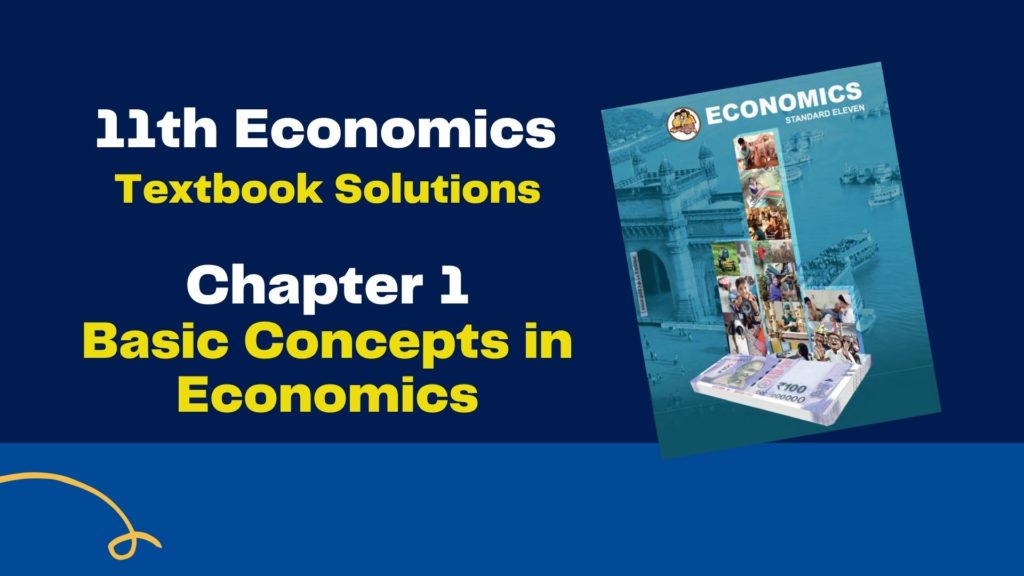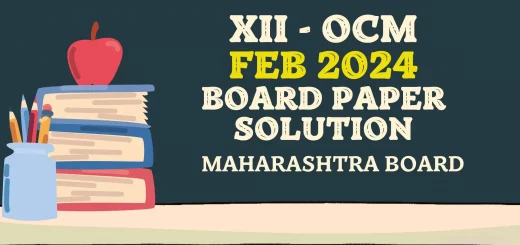11th Economics Chapter 1 Exercise Answers (Basic Concepts in Economics) Maharashtra Board – Free Solution
Table of Contents
11th Economics Chapter 1 Exercise

Chapter 1 – Basic Concepts in Economics
Q. 1. Choose the correct option
1) Statements related to Economics:
a) Economics is a social science.
b) Concept of economics is derived from Greek word ‘Oikonomia’.
c) Economics is related to the study of human economic behavior.
d) Economics is related to management of the household.
Options:
1) a, b and c
2) a and b
3) b and c
4) a, b, c and d
2) Statements incorrect with reference to Adam Smith’s definition:
a) Adam Smith is a classical economist.
b) Wealth of Nations is authored by Adam Smith.
c) Economics is the science of wealth.
d) Economics studies common man.
Options:
1) d
2) a, b and c
3) a and d
4) c and d
3) Key points in Lionel Robbins’ definition:
a) Wants are unlimited
b) Means are limited
c) Wants are not gradable
d) Means have alternative uses.
Options:
1) a and b
2) b and c
3) a, b and d
4) a, b, c and d
4) Statements related to wealth:
a) Wealth means anything which has market value and can be exchanged for money.
b) It is external to human being.
c) Wealth has no utility.
d) Wealth is scarce and exchangeable.
Options:
1) a, b and d
2) a, c and d
3) b, c and d
4) None of the above
5) Aspects considered in National Income:
a) Final goods and services are included in national income.
b) Produced goods and services in a financial year are included in national income.
c) Double counting is avoided.
d) Value is considered as per market price.
Options:
1) a and c
2) b and c
3) a, b and d
4) a, b, c and d
Q. 2. Complete the correlation
1) Natural science : Exact science : : Social science : Abstract Science
2) Physics : Natural science : : Psychology : Social sciences
3) Arthshastra : Kautilya : : Wealth of Nations : Adam Smith
4) Necessity : Food : : Comforts : Washing machine
5) Free goods : Value-in-use : : Economic goods : Value in Exchange
Q. 3. Identify and explain the concepts from the given illustrations
1) My father purchased a two wheeler vehicle. This helps to fulfill my travel needs.
Concept: Individual Want
Explanation: Personal or individual wants refer to those wants which are satisfied at the individual level, e.g. a doctor using a stethoscope, a judge wearing his coat.
2) A study of the annual income of the family of Ramesh.
Concept: Microeconomics
Explanation: Micro Economics deals with the behaviour of the individual variables such as a household, worker, firm, industry, etc.
3) As per the data for financial year 2018-19, the country’s production of goods and services increased by 20%.
Concept: Economics Growth
Explanation: Economic growth means an increase in the real national income of the country, over a long period of time.
4) Karuna’s mother saves Rs.1000/- every month out of her given salary.
Concept: Savings
Explanation: Saving is that part of income that is not spent currently on consumption.
5) Ram’s father utilized his provident fund amount to set up grocery store.
Concept: Investment
Explanation: Investment refers to the creation of capital assets through mobilization of savings, e.g. machinery, equipment etc.
Solution of other subjects
Solution of all Chapters of Economics
1 – 2– 3 – 4 – 5 – 6 – 7 – 8 – 9 – 10
Q.4. Answer the following
1) Explain the features of wealth.
Answer: Wealth refers to “anything which has market value and can be exchanged for money.”
Following are the features of wealth.
i) Utility: A commodity must have the capacity to satisfy human wants, e.g. furniture, refrigerator etc.
ii) Scarcity: A commodity must be scarce in supply in relation to its demand if it is to be included in the term ‘Wealth’, e.g. all economic goods for which price is paid.
iii) Transferability: A commodity should be transferable from person to person as well as from place to place. If the good is material or tangible then only it is possible to transfer it from place to place, e.g. vehicle, jewellery, etc.
iv) Externality: A good can be transferred only if it is external to the human body, e.g. bag, chair, etc.
2) Explain the characteristics of human wants.
Answer: In economics, want denotes a feeling of ‘lack of satisfaction’.
Characteristics of wants:
i) Wants are unlimited: Wants not only arise again and again but they are also unending. If one want gets satisfied, another arises. Wants go on multiplying in number.
ii) Wants are recurring in nature: Several human wants occur again and again, while some might be only occasional.
iii) Wants differ with age: Wants and their satisfaction differ as per the chronological age.
iv) Wants differ with gender: Men and women want different goods according to their needs.
v) Wants differ due to preferences: Individual habits, tastes and preferences matter a lot while deciding wants of the people.
vi) Wants differ with seasons: Wants keep on changing with seasons.
vii) Wants differ due to culture: Differences in culture influence wants that are related to food, dressing styles etc.
Q.5. State with reasons whether you agree or disagree with the following statements
1) All wants can be satisfied at a time.
Answer: No, I disagree with this statement.
Reasons: a) Human wants are unlimited and means to satisfy them are limited.
b) They are unending. If one want gets satisfied, another arises. Wants go on multiplying in number.
c) Some human wants occur again and again even if satisfied once.
d) Therefore, all wants cannot be satisfied at a time.
2) Human wants change as per the seasons and preferences.
Answer: Yes, I agree with this statement.
Reasons: a) In economics, want denotes a feeling of ‘lack of satisfaction’.
b) This feeling enables the individual to satisfy his want.
c) Human wants differ with seasons. Example a person require woolen cloths in winter and umbrella in rainy season.
d) Wants also differ with preferences, i.e they are influenced by individual habits and taste.
3) Value-in-use and Value-in-exchange are the same.
Answer: No, I disagree with this statement.
Reasons: a) Value-in-use refers to the worth of a commodity. It is usefulness of a commodity, e.g. no one has to pay price for sunshine but its immense worth for life can never be doubted.
b) In economic language, sunshine has a high value-in-use. It is an example of ‘free good’.
c) Value-in-exchange refers to the worth of a commodity or a service expressed in terms of another commodity. When this value is expressed in terms of money, it is called price of a commodity.
d) A good which commands a price is termed as an ‘economic good’, e.g. TV, car etc.
Thus, Value-in-use and Value-in-exchange are not same.
Solution of other subjects
Solution of all Chapters of Economics
1 – 2– 3 – 4 – 5 – 6 – 7 – 8 – 9 – 10
Q.6. Answer in detail
1) Explain the basic concepts of macro economics.
Answer: Macro Economics deals not with individual quantities as such, but with the aggregates of these quantities, not with the individual incomes but with the national income, not with individual prices but with the general price level, not with individual output but with the national output”.
Basic Concepts of Macro Economics are as follows:
1) National Income:
This reveals the total economic performance of a nation. It is referred to as the total income of a country.
2) Saving:
It is that part of the income which is set aside to satisfy future needs by foregoing current consumption. In other words, saving is that part of income that is not spent currently on consumption.
3) Investment:
It refers to the creation of capital assets through mobilization of savings, e.g. machinery, equipment, etc.
4) Trade Cycles:
Trade cycles are fluctuations in business. They are ups and downs in the overall economic activities. Ups and downs mean fluctuations caused by inflation and depression respectively.
• Inflation is a continuous rise in general price level.
• Depression is a continuous fall in overall prices and a lowering down of economic activity in general.
5) Economic Growth:
The term economic growth has a ‘quantitative’ dimension. In simple words, economic growth means an increase in the real national income of the country, over a long period of time.
6) Economic Development:
This is a wider concept that has a ‘qualitative’ dimension. Economic development implies economic growth plus progressive changes in certain important variables that determine the well-being of the people, e.g. education, health etc.
11th Economics Textbook Solutions
| Chapter Name | Solution Link |
| 1) Basic Concepts in Economics | Solution |
| 2) Money | Solution |
| 3) Partition Values | Solution |
| 4) The Economy of Maharashtra | Solution |
| 5) Rural Development in India | Solution |
| 6) Population in India | Solution |
| 7) Unemployment in India | Solution |
| 8) Poverty in India | Solution |
| 9) Economic Policy of India Since 1991 | Solution |
| 10) Economic Planning in India | Solution |
Check out other posts related to 11th Commerce
| Textbook Solutions of 11th Commerce (All Subjects) | Click Here |
| Free pdf of 11th Commerce Textbooks | Click Here |


![12th SP Paper Pattern Maharashtra Board (2025-26) [Download Free PDF] 5 12th SP Paper Pattern](https://scholarsclasses.com/blog/wp-content/uploads/2021/10/12th-SP-Paper-Pattern-520x245.jpg)
1 Response
[…] Solution […]